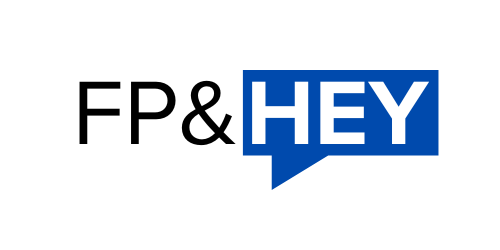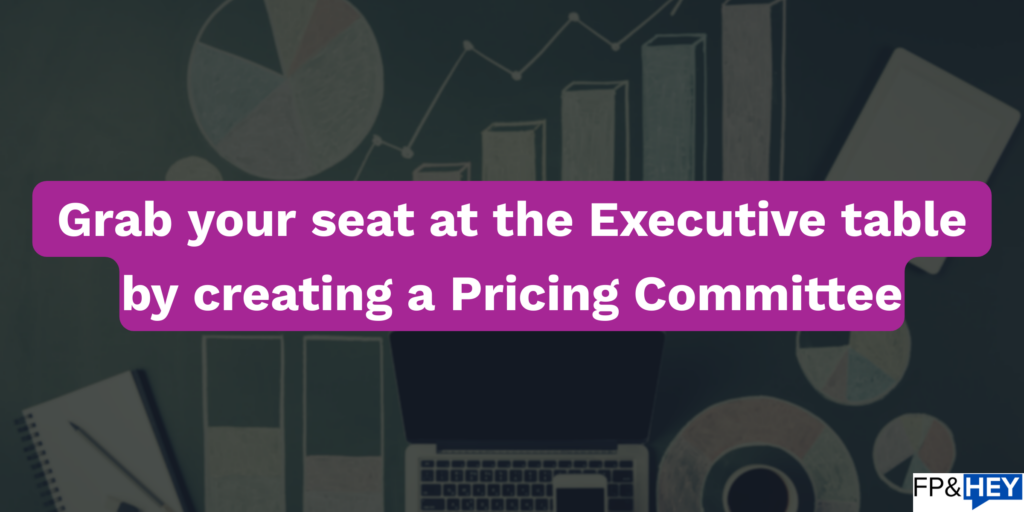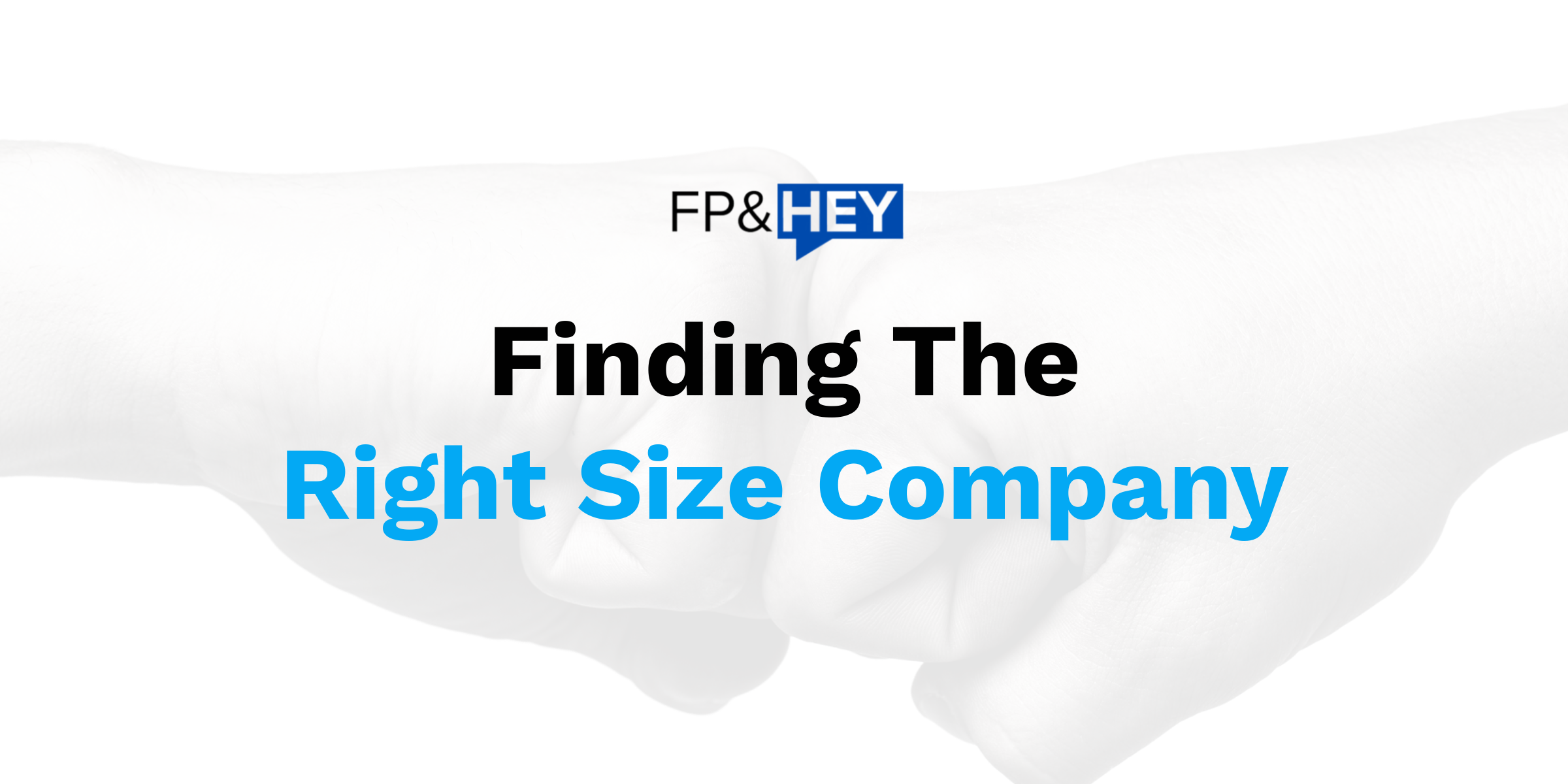👋 Hey there,
In case you missed it, our guest appearance on FP&A Today aired last week.
Drew shares what he has learned over his 20 years in FP&A.
🎧 Listen on Apple | Spotify | DataRails | YouTube
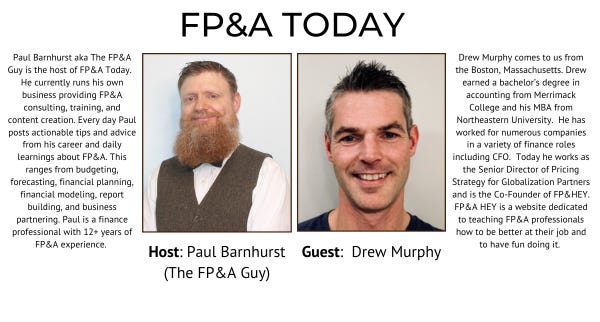
Now onto our post.
Do you have FP&A skills that could impress your Executive team?
Show them off!
We did at multiple companies doing the same thing each time.
How?
By standing up a Pricing Committee.
This post covers how to grab your seat at the Executive table by creating a Pricing Committee.
We’ll cover the following:
- What motivates your Executive team
- How FP&A supports executive decisions
- Why Pricing is important to your company
- What is a Pricing Committee and how can you stand one up
- How Drew transformed from Plant Accountant to Pricing Committee guru
There is no magic to standing up a Pricing Committee.
Your FP&A skills, data, and business partner connections are all you need.

Use them to get your shot at impressing your Executives.
Which can help you open some serious career doors. 💪
Let’s dive in.
What motivates your Executive team
To help anyone at any level, you need to understand their goals.
Your Executives cover all departments of your company’s operations:
- Sales
- Marketing
- Product
- Operations
- Finance
- Legal
- HR
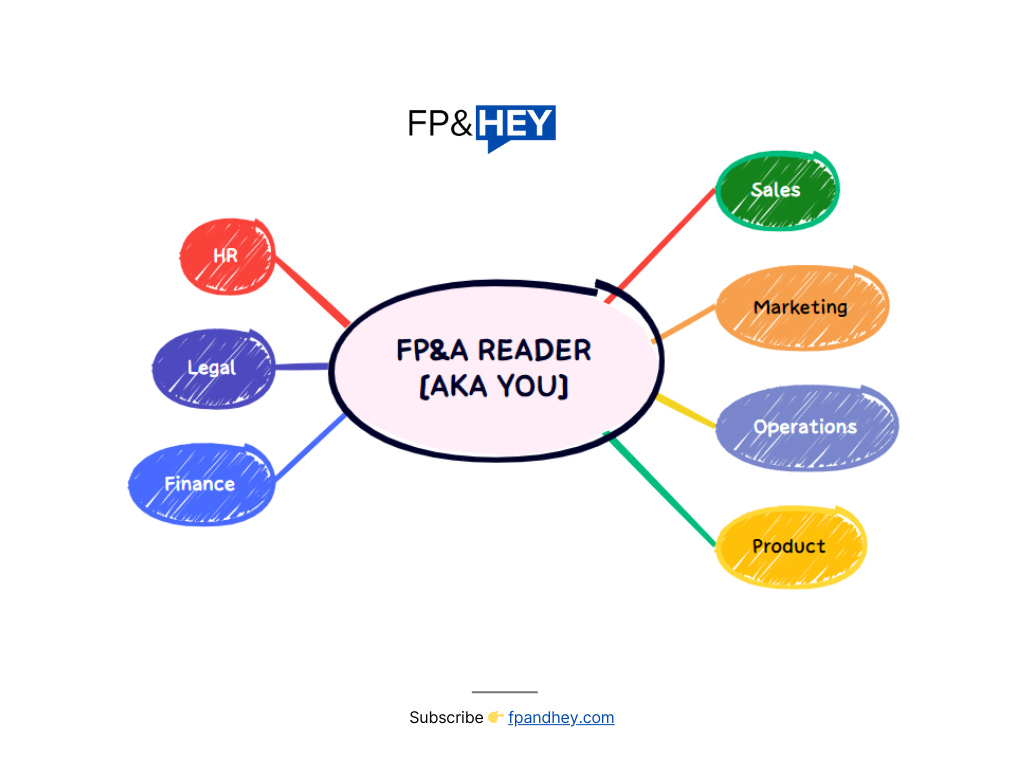
What’s the shared goal of all your Executives?
Driving the success of your company.
Your Executives are motivated by your company’s success in a few ways:
✅ Personal financial gain tied to company performance
✅ Fulfilling a strategic vision
✅ Enabling their own team’s success
And guess what’s key to determining company success?
Financial data.
That’s good news for you in FP&A.
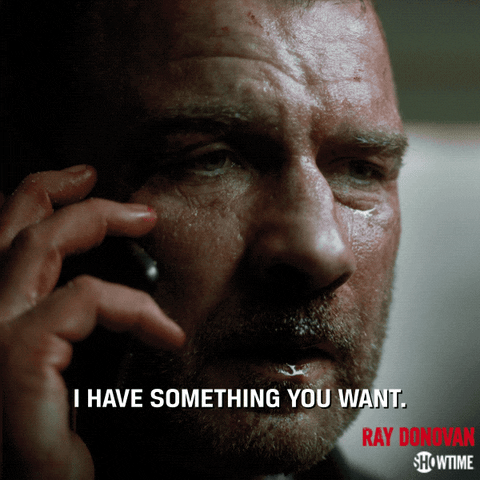
How FP&A supports executive decisions
Revenue, expenses, and cash are three KPIs executives watch like a hawk.
🔥TIP: Read this to understand what a KPI is
They are the KPIs that determine the success or failure of a company over time.
In FP&A you can track KPIs through month-end reporting.
And there are a number of ways to improve these KPIs.
One of them has the biggest impact of all and is the MOST overlooked.

Pricing.
Why pricing is important to your company’s success
Managing price can have a bigger impact on revenue than customer acquisition and retention.
And it has a direct impact on your bottom line.

Just ask legendary investor Warren Buffett.
“The single-most important decision in evaluating a business is pricing power. If you’ve got the power to raise prices without losing business to a competitor, you’ve got a very good business.”
-Warren Buffett, Chairman and CEO, Berkshire Hathaway (source)
The challenge with pricing is that it spans many departments, requires many perspectives, and rarely has clear ownership.
Bringing the right people together can help with these challenges.
Time to assemble the Pricing Committee.

What is a Pricing Committee
A Pricing Committee is a team of extraordinary, cross-functional talent.
Its mission:
Make timely pricing decisions that maximize revenue and profits.
🔥TIP: Read this to understand pricing strategy in full detail
Some pricing decisions have long lead times, like how to package your new product.
Other pricing decisions require quick decisions, like testing a discount campaign.
Does your company have a team dedicated to tackling any and all pricing-related decisions?
It will when you stand up your Pricing Committee.
What are the benefits of a Pricing Committee
Put simply, a Pricing Committee will help your company get sh#t done.

By forming a Pricing Committee, you’re creating ownership and accountability around the topic of pricing.
For example, what happens if your competition drops its price TODAY?
You’ll need people to pull specific information together in a timely manner to make an informed decision.
Comprehensive analysis
You need to consider many things when making pricing decisions like:
- Market trends
- Customer behavior
- Competitive intelligence
Some of this data is qualitative, some quantitative.
This data can live in Marketing, Sales, Operations, Finance…it all depends on your company’s structure.
And some of this data may not exist in your company yet.

There could be A LOT of opportunity for you and your colleagues.
Leverage the talents of your cross-functional team to gather, analyze, and provide recommendations.
Financial consideration
With lots of data comes financial impact.
Having FP&A gurus like yourself involved ensures financial rigor exists.
Consider how pricing can impact things like:
- Your long-term financial goals
- Your short-term financial performance
- Your customer lifetime value (CLTV)
🔥TIP: Read this to learn how to assess your company’s CLTV
Business strategy alignment
How does your company want to position its products?
Ask yourself and your Pricing Committee members:
❔ Is your product premium and priced accordingly?
❔ Is your product low-priced and going for volume?
❔ Does your product have value that competition can’t beat?
What if your company wants to offer a low-priced and premium offering?
You’ll need a well-thought-out strategy to pull it off.
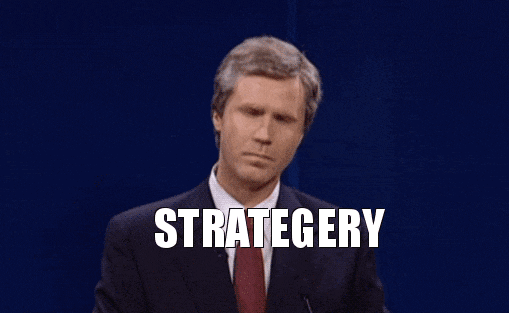
Just look at Toyota (low-cost brand) and how they launched Lexus (premium brand).
Help your company figure out its pricing strategy and get buy-in from the top.
Leadership engagement
Your company’s strategy comes from the top.
Getting active participation from leadership is the support you’ll need when making long-term and urgent pricing decisions.
You may even find that your analysis and recommendations can change the course of your company’s strategy.
Add that to your resume to land future jobs. 👊

Continuous monitoring and improvement
Pricing can change at the drop of a hat.
Be prepared to analyze information and make recommendations quickly if needed.
To stay on top of things, you and your Pricing Committee should constantly review:
- Your competition’s website, specifically their pricing page
- Your win/loss data from Sales calls
- Your customers’ profitability and Net Promoter Score (NPS)

Making timely decisions can be the difference between hitting your goals or being beaten by competition.
So how the heck do you set up a Pricing Committee?
How to set up a Pricing Committee
Standing up a Pricing Committee requires a lot of people, data, and organization.
That’s why you (FP&A guru) are the perfect person to pull it off.

Get an Executive Sponsor
First, get buy-in from one Executive to sponsor your Pricing Committee.
This is usually the CFO or CRO because of their direct ownership of revenue performance.
This Executive Sponsor will become the primary decision maker in case of ties.
They will also be your advocate for pulling together people from various departments and levels.
From there, start building out the teams.

Assemble two teams
You will have two teams in your Pricing Committee.
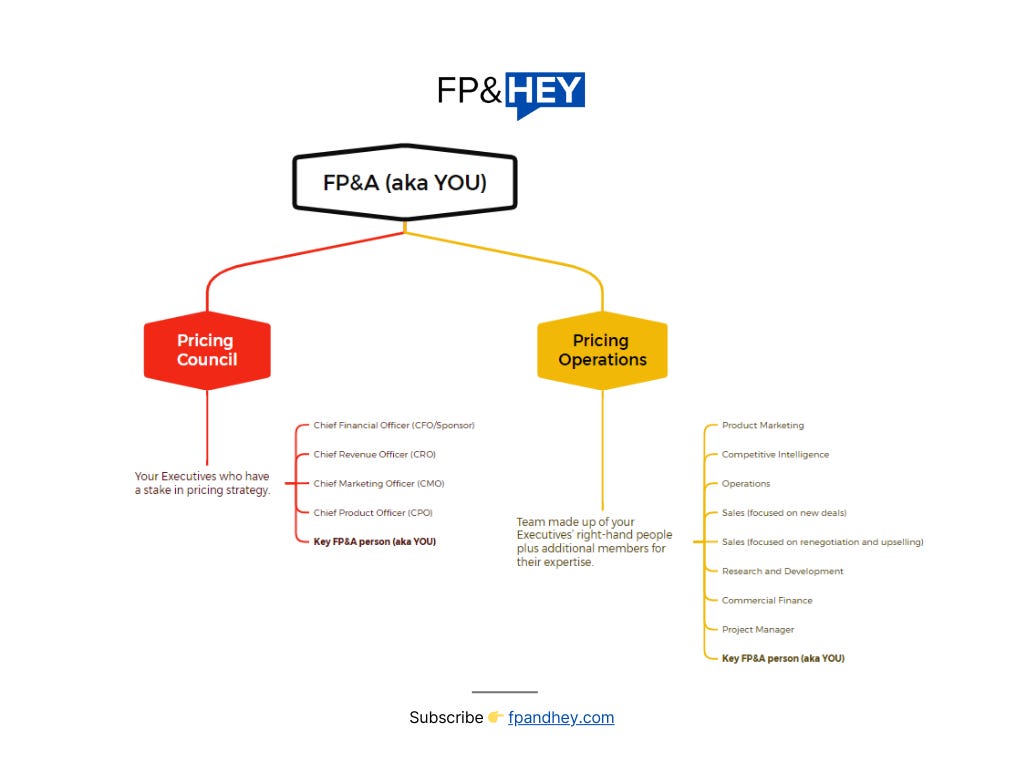
The first team is the Pricing Council.
This team is made up of your Executives who have a stake in pricing strategy.
This team makes official decisions, with the Sponsor being the official tie-breaker.
People to include in the Pricing Council include:
- Chief Financial Officer (CFO/Sponsor)
- Chief Revenue Officer (CRO)
- Chief Marketing Officer (CMO)
- Chief Product Officer (CPO)
- Key FP&A person (aka YOU)
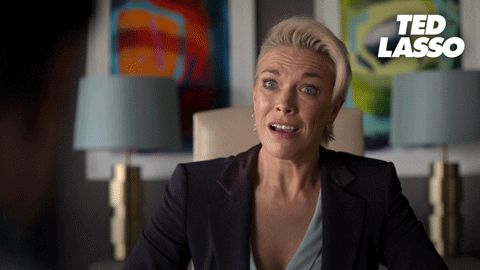
And yes, YOU (key FP&A person) are included in this group to serve as the connection between this Pricing Council and the second team.
The second team is the Pricing Operations Group.
This team is made up of your Executives’ right-hand people plus additional members for their expertise.
Members of the Pricing Operations Group could include:
- Product Marketing
- Competitive Intelligence
- Operations
- Sales (focused on new deals)
- Sales (focused on renegotiation and upselling)
- Research and Development
- Commercial Finance
- Project Manager
- Key FP&A person (aka YOU)
This high-powered team captures feedback, performs analysis, and delivers recommendations.

And yes, you are on this team too to be the connection between both teams.
The Pricing Council may give the Pricing Operations Group autonomy to make decisions on its own by using certain frameworks.
Other bigger decisions will require discussion with the Pricing Council.
Meet often and make decisions
Your meeting cadence will depend on your own company’s preferences.
Use this framework as a guide and adjust as needed:
- Pricing Operations Group – meets weekly
- Pricing Council – meets monthly

Pricing Operations Group meetings are all about capturing critical issues that require decisions in order to move the business forward.
✔️ Capture them on a list
✔️ Rank them by priority
✔️ Assign an owner to gather the data needed
✔️ Make it a to-do item to generate an informed recommendation
Each week manage this list, and leading up to your Pricing Council meeting make this list the topic of discussion.
Pricing Council meetings are all about making decisions to pave the way for action.
✔️ Review monthly results for company performance context
✔️ Summarize the issues to be discussed
✔️ Deep dive into each issue with a recommendation and data to support
✔️ Track official decisions or requests for more info
These two meetings combined with the members involved can provide serious decision-making support.
We’ve seen it firsthand in our own careers multiple times.
How Drew went from Plant Accountant to Pricing Committee guru
Your career has to start somewhere.
Here’s a real story of how Drew went from Plant Accountant to Pricing Committee guru.
Here are the big career steps he made to get involved in his first Pricing Committee.
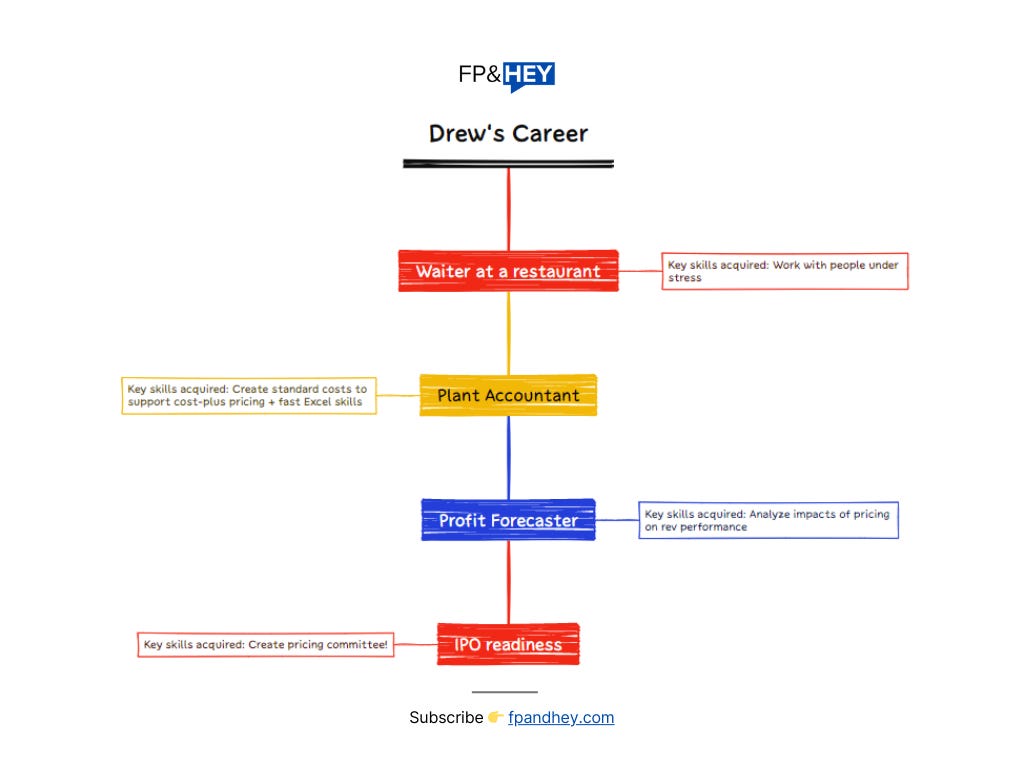
Waiter at a restaurant
So let’s go WAY back.
The restaurant industry is fast-paced, and customers’ personalities can be challenging.
Drew was a waiter and made every mistake in the book.
Including spilling red wine on a young girl’s white dress (can’t make this up).

He was able to get his biggest tip ever from the parents of that little girl who now has a pink dress.
How?
He was very lucky they were nice people.
AND he also went above and beyond to make them happy regardless of the tough start to their evening.
He apologized, made them laugh, and even spilled red wine on his own white t-shirt to make that little girl feel like she was part of a pink outfit club.
💪Key skills acquired: The ability to work with people under stress and among numerous personality types.
Plant Accountant
Drew took his waiting talents (or lack thereof) to the business world.
Telling that red wine story actually helped him ace his interview.
🔥TIP: Read this to learn how to ace your next FP&A interview
Drew started as a Plant Accounting Intern with no knowledge of Excel or any clue about how to close the books.
🔥TIP: Read this if you want to be faster in Excel
His tasks included:
- Writing over 100 journal entries each month
- Creating balance sheet review books (so many papercuts)
- Calculating standard costs for production units

At first glance, these tasks have ZERO to do with pricing.
Look again.
One big pricing strategy is cost plus—the idea of understanding how much each unit you sell costs.
💪Key skills acquired: Creating standard costs to support cost-plus pricing and Excel skills to analyze data fast.
Profit Forecaster
Drew took his Excel skills and knowledge of the cost of aluminum cans to the profit forecast realm.
🔥TIP: Read this to learn how to profit forecast
His company launched a new premium blade when his profit forecasting role started.
This new blade impacted revenue performance by driving the price per unit higher.
He was tasked with explaining how much this new product impacted revenue.
This introduced him to the concept of volume, mix, and price (VMaP).
🔥TIP: Read this to learn how to perform VMaP analysis
💪Key skills acquired: Ability to analyze the impact of pricing on revenue performance.
IPO readiness
For a company to go public, it must have a compelling revenue and profit story.
🔥TIP: Read this to learn how to tell a great customer journey story
Understanding the unit economics of your products and customers is key.
How do you do that?
- Understand revenue performance using VMaP
- Allocate costs to determine customer and product profitability
- Visualize that analysis for actionable insights using a dashboard
🔥TIP: Read this to learn how to use bubble charts to visualize analysis
Drew leveraged his prior learnings to pull this analysis together.
But one thing was missing.
The medium to make strategic decisions based on findings from this analysis.
What did Drew help build to solve this problem?

A Pricing Committee!
Conclusion: You can pave your own Pricing Committee path
You now know what skills it takes to build or participate in a Pricing Committee.
And you’ve seen a path to get there.
Your career will take its own unique path.
And you’ll acquire skills, make connections, and find interesting things to work on along the way.
While doing so, you’ll work with people at all levels of your company, including leadership.
Which will help you open future career doors.
Enjoy your career journey. 👊
Ready to build a Pricing Committee to help you grow your career?
Let us know by emailing us with your experiences and thoughts.
As always, let us know if you have topics you’d like us to cover to help you grow your FP&A career. We read every message.
Now go have fun making an impact on your business and your career!
Cheers,
Drew & Yarty
Follow us on LinkedIn
PS: This post is 100% human-made 💪

